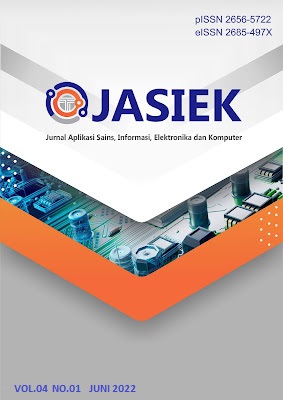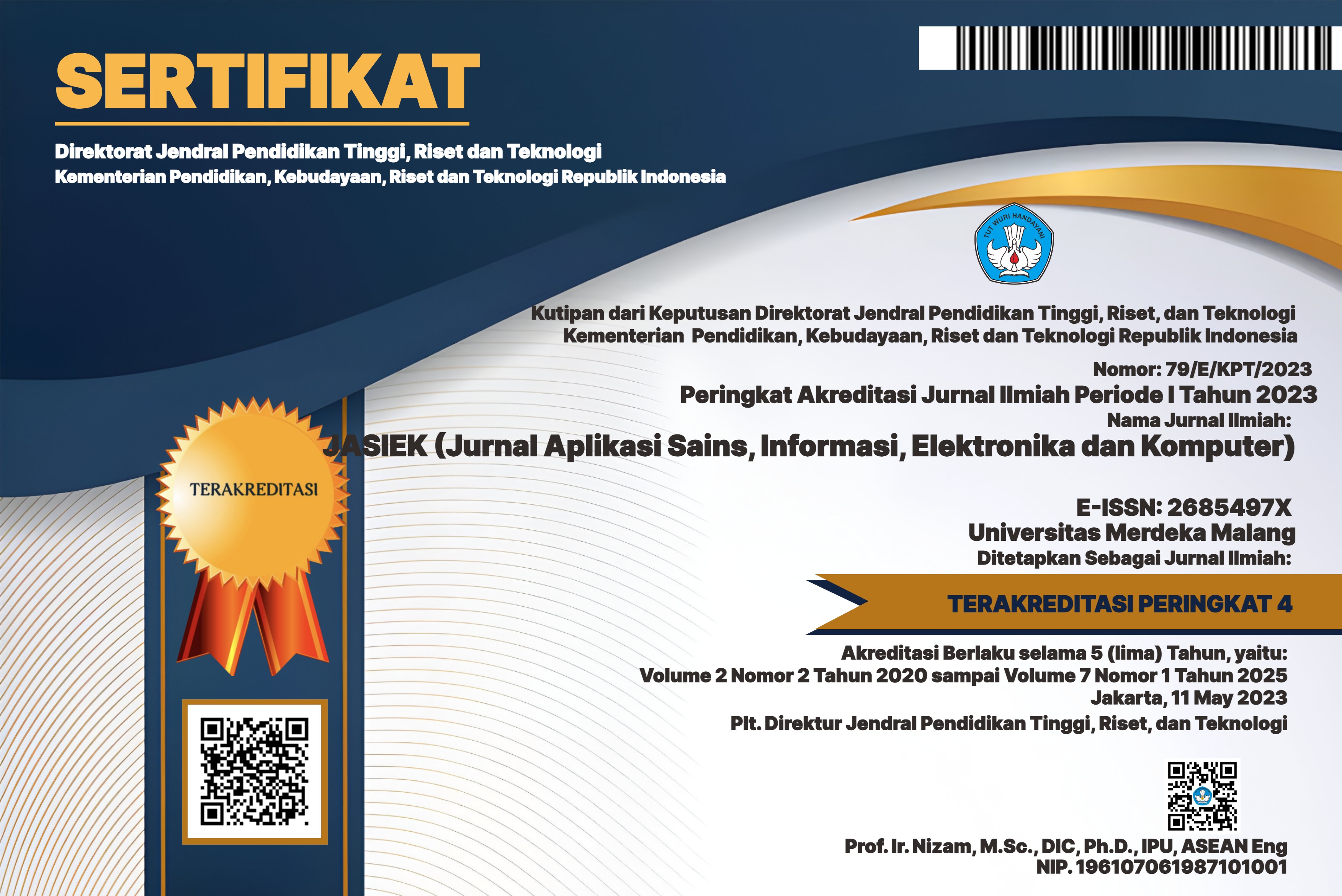Alat Pengukur Status Gizi Balita Berdasarkan Berat dan Panjang Badan Menggunakan Indeks Antropometri Dengan Metode Logika Fuzzy
DOI:
https://doi.org/10.26905/jasiek.v4i1.8352Keywords:
Antropometri, Delphi, Fuzzy, Nutritional Status, ToddlerAbstract
The health sector is crucial today. Various medical devices were created to facilitate the work of health workers. One of them is in the routine measurement of nutritional status by measuring the weight and length of children under five at the Posyandu. Several tools used to measure nutritional status are still working separately, and health workers are still calculating nutritional status manually. The purpose of this study is to design a tool that can measure the nutritional status of toddlers by using measurements of weight and length of toddlers simultaneously based on Anthropometric index calculations and comparing with fuzzy calculation analysis to support the results. The results of nutritional status, in this study, used 2 calculations, namely the calculation of the anthropometric index and the analysis of fuzzy measures. Based on the anthropometric index, the assessment of nutritional status used the variables of weight, body length, age, and gender (M/F). The calculation of these variables is processed in the Arduino Mega 2560 microcontroller and then displayed on the LCD and the Delphi program. A loadcell sensor is used to measure body weight, and a multiturn potentiometer is used to measure body length. Fuzzy calculation analysis used Mamdani, body length/age, and weight/body length methods as input from the anthropometric index and body weight/age to support calculations. The results of this study obtained a measuring tool for the nutritional status of toddlers that can bring up nutritional status based on anthropometric indexes and analysis of Fuzzy Mamdani calculations. This nutritional status measuring device can be used to make it easier for health workers to monitor the development of toddlersDownloads
References
N. Fajri, “Rancang bangun alat ukur tinggi dan berat badan bayi berbasis mikrokontroler ATMEGA8535 dengan sensor fototransistor,†Jurnal Fisika Unand, vol. 3, no. 3, pp. 163–169, 2014.
G. L. Annisya, “PERANCANGAN ALAT MONITORING GIZI BURUK (BERAT BADAN, LEMAK DAN KARBOHIDRAT),†2017.
W. Palasari and D. Purnomo, “Keterampilan ibu dalam deteksi dini tumbuh kembang terhadap tumbuh kembang bayi,†Jurnal Stikes, vol. 5, no. 1, pp. 11–20, 2012.
H. Hasrul, H. Hamzah, and A. Hafid, “Pengaruh Pola Asuh Terhadap Status Gizi Anak,†Jurnal Ilmiah Kesehatan Sandi Husada, vol. 9, no. 2, pp. 792–797, 2020.
R. I. Kemenkes, “Standar antropometri penilaian status gizi anak,†Jakarta: Direktorat Bina Gizi, pp. 35–40, 2011.
N. D. I. Supariasa, B. Bakri, and I. Fajar, “Penilaian Status Gizi, Antropometri Gizi,†Jakarta: Buku Kedokteran EGC, 2002.
N. Puspasari and M. Andriani, “Hubungan pengetahuan ibu tentang gizi dan asupan makan balita dengan status gizi balita (BB/U) usia 12-24 bulan,†Amerta Nutrition, vol. 1, no. 4, pp. 369–378, 2017.
H. Nasution, “Implementasi Logika Fuzzy pada Sistem Kecerdasan Buatan,†jurnal ELKHA, vol. 4, no. 2, 2012.
R. Meimaharani and T. Listyorini, “Analisis sistem inference fuzzy Sugeno dalam menentukan harga penjualan tanah untuk pembangunan minimarket,†Simetris: Jurnal Teknik Mesin, Elektro dan Ilmu Komputer, vol. 5, no. 1, pp. 89–96, 2014.
R. F. Pitaloka, “PERANCANGAN ALAT MONITORING GIZI BURUK (PANJANG BADAN, ANGKA KEBUTUHAN ENERGI DAN PROTEIN),†2017
Downloads
Published
Issue
Section
License
Authors who publish with this journal agree to the following terms:
The journal allow the authors to hold the copyright without restrictions and allow the authors to retain publishing rights without restrictions.
Authors retain copyright and grant the journal right of first publication with the work simultaneously licensed under a Creative Commons Attribution-ShareAlike 4.0 International License that allows others to share the work with an acknowledgement of the work's authorship and initial publication in this journal.
Authors are able to enter into separate, additional contractual arrangements for the non-exclusive distribution of the journal's published version of the work (e.g., post it to an institutional repository or publish it in a book), with an acknowledgement of its initial publication in this journal.
Authors are permitted and encouraged to post their work online (e.g., in institutional repositories or on their website) prior to and during the submission process, as it can lead to productive exchanges, as well as earlier and greater citation of published work (See The Effect of Open Access).

This work is licensed under a Creative Commons Attribution-ShareAlike 4.0 International License.











